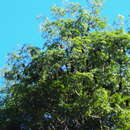Biology
provided by Arkive
Gathering in mixed-sex groups of up to 850 individuals to roost, the Pemba flying fox creates quite a spectacle. The bats remain faithful to their roost (often a group of large, mature trees), returning from feeding trips in huge flocks (2). They feed on mangos, breadfruit, figs, flowers and leaves, and may be the only species on the island that disperses larger seeds, thereby proving essential to those plants that produce them (6). Unlike insectivorous bats (Microchiroptera), they do not use echolocation, instead using vision to locate fruit.
Mating is thought to occur between January and April, with births between June and August (2). The young are independent within three to six months (3).
Conservation
provided by Arkive
There are no laws restricting the hunting of bats on Pemba, but hunting is restricted in certain forest areas where the Pemba flying fox is found. A captive breeding programme for the bat was established at Phoenix Zoo, Arizona, USA in 1994 (2).
Description
provided by Arkive
With characteristic dog-like facial features, this large fruit bat has chestnut red fur, a black face and black wings. The males are larger and darker in colour than the females (2).
Habitat
provided by Arkive
The Pemba flying fox is found in both primary and secondary forest, as well as in graveyards and mangroves (5).
Range
provided by Arkive
Endemic to Pemba Island, 40 km off the coast of mainland Tanzania in the Indian Ocean (1). Ninety-four percent of the Pemba flying fox population is found in just ten roost sites (5).
Status
provided by Arkive
The Pemba flying fox is classified as Vulnerable (VU D2) on the IUCN Red List 2004 (1) and is listed on Appendix II of CITES (4).
Threats
provided by Arkive
By inhabiting graveyards the Pemba flying fox gains some protection, as these are seldom visited due to local taboo. Bats provide a source of protein for the inhabitants of Pemba Island, but they are not hunted on a commercial level. However, as shotguns increase in prevalence, hunting may become more common (2). Deforestation as a result of logging and the conversion of forests to agricultural land also poses a threat to the survival of the Pemba flying fox (5)

